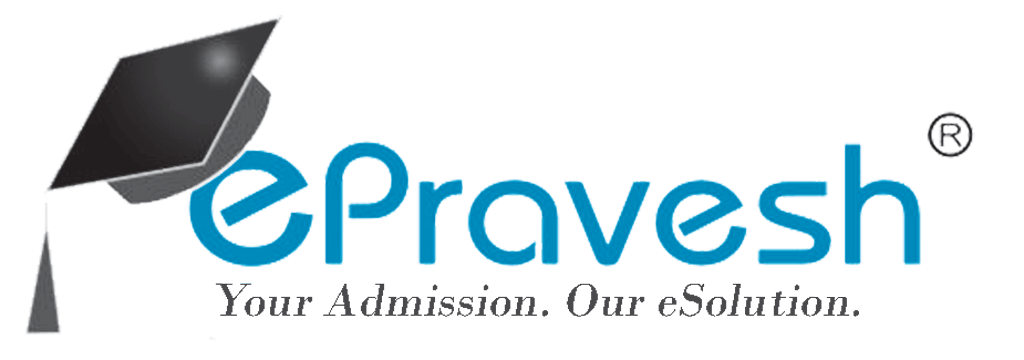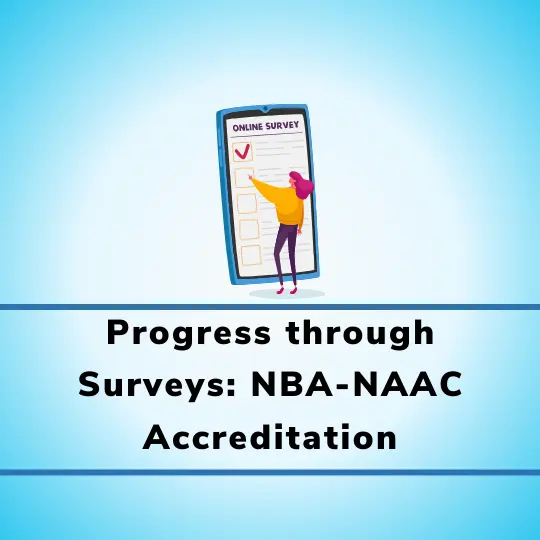
Article Contents
Introduction
Want to learn how surveys help NBA/NAAC Accreditation and how educational institutions improve it? Here we go! Seeking recognition from NBA/NAAC boosts an institution’s reputation, showing they are committed to providing an amazing learning experience. Assessing Course Outcomes (CO) and Program Outcomes (PO) is crucial for quality education.
Surveys, both direct and indirect, are fantastic tools for this assessment. They gather valuable feedback from different stakeholders, making the process attractive and inclusive. These surveys play a big role in the accreditation process, ensuring continuous improvement.
In this article, we will explore the use of surveys, both direct and indirect methods, as powerful tools to assess CO and PO, while maintaining a balanced Weightage.
Importance of course outcomes and program outcomes
Course outcomes are specific, measurable, and achievable learning objectives for individual courses. On the other hand, program outcomes are broader and encompass the overall skills and knowledge students should acquire throughout their academic journey. Both course and program outcomes help institutions evaluate the effectiveness of their curriculum and ensure that students are meeting the necessary learning benchmarks.
Assessment Methods: Direct vs. Indirect Method
Assessment is a systematic process conducted by educational institutions to evaluate the attainment of Course Outcomes (CO) and Program Outcomes (PO). These outcomes represent the knowledge, skills, and competencies that students should acquire by the end of a course or program. Institutions employ two primary methods for assessment: direct and indirect methods.
Direct assessment involves the evaluation of students’ actual performance through examinations, assignments, projects, or other practical tasks. This method provides tangible evidence of learning outcomes and is commonly used for assessing CO and PO.
On the other hand, the indirect assessment method relies on gathering stakeholders’ perspectives, opinions, and feedback to infer students’ learning and the overall program’s effectiveness. This approach allows various stakeholders, including students, alumni, faculty, employers, and parents, to reflect on their experiences and offer valuable insights.

Understanding the Indirect Method: Surveys and Interviews
In the context of assessing CO and PO, the indirect method extensively employs surveys and interviews. Surveys are structured questionnaires designed to capture respondents’ opinions and experiences, while interviews involve in-depth conversations to gain qualitative insights.
Through surveys, we can collect information from many different people involved in the educational program. This means we get a complete and amazing picture of what’s going on. So, we want to hear from students, teachers, graduates, and even employers!
Surveys Involving Key Stakeholders
- Student Satisfaction Surveys: These surveys gauge students’ satisfaction with their educational experience, including the curriculum, teaching methods, facilities, and overall learning environment.
- Faculty Evaluation Surveys: Faculty evaluation surveys are administered to students to gather feedback on the performance of instructors and professors. These surveys assess teaching effectiveness, communication skills, and the ability to engage students
- Parent Surveys: Parents’ perspectives on their children’s educational journey provide a unique outlook on the institution’s commitment to student development and success.
- Alumni Feedback Surveys: Alumni feedback surveys help gather information from graduates about how well the educational program prepared them for their careers and the extent to which the program met their expectations.
- Employer Satisfaction Surveys: These surveys seek feedback from employers of graduates to understand their satisfaction with the skills and knowledge of the hired graduates and the relevance of the education provided.
- Placement Surveys: Placement surveys collect data on the employment status of recent graduates, including the industries they are employed in, job roles, and their perceived preparedness for the workforce.
- Assessment of Support Services: These surveys focus on evaluating support services provided by the institution, such as academic advising, counseling, career services, and extracurricular activities.
- Teaching and Learning Effectiveness Surveys: These surveys assess the effectiveness of various teaching and learning strategies, instructional resources, and technologies used in the classroom.
- Program Evaluation Surveys: Program evaluation surveys help assess the overall effectiveness and impact of specific educational programs or courses.
- Institutional Effectiveness Surveys: These surveys measure the overall effectiveness and quality of the institution as a whole, including its mission, vision, and strategic goals.
- Student Engagement Surveys: These surveys assess students’ involvement and engagement in various academic and extracurricular activities, which can influence their learning outcomes and overall experience.
- Diversity and Inclusion Surveys: These surveys focus on understanding the diversity and inclusion climate within the institution, addressing topics such as cultural competency and inclusivity.
- Technology Adoption Surveys: Technology adoption surveys assess the usage and effectiveness of technology in educational settings, including learning management systems and digital resources.
Types of Questions in Surveys
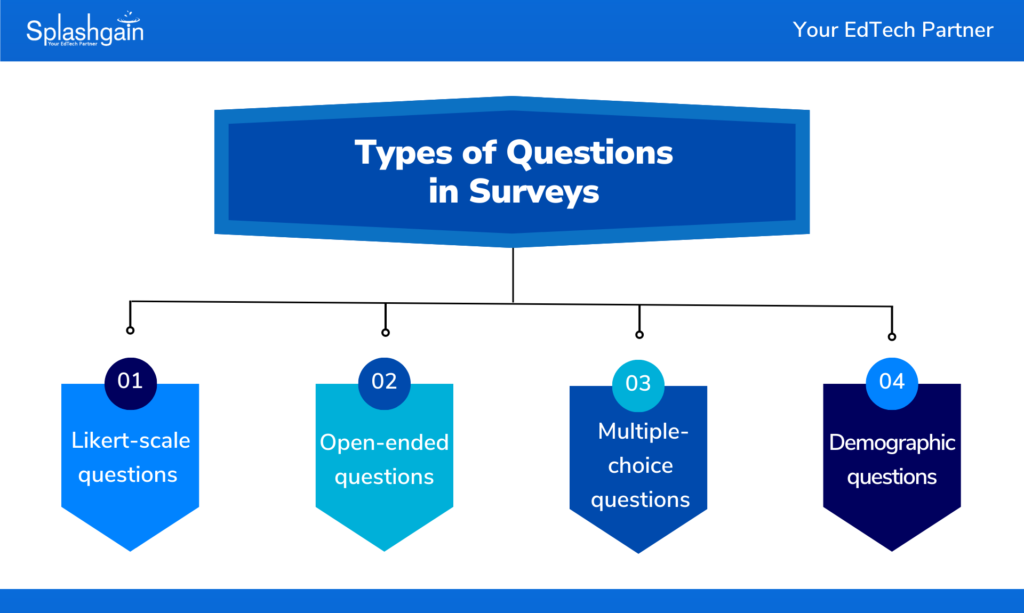
A. Likert-scale questions to measure perceptions and attitudes
Likert-scale questions are commonly used in surveys to gauge respondents’ perceptions, attitudes, opinions, and feelings towards specific topics or experiences. They offer a range of response options, usually ranging from “strongly disagree” to “strongly agree” or similar variations.
Examples:
- How strongly do you agree or disagree that the course materials were relevant to the stated learning objectives?
- On a scale of 1 to 5, how confident do you feel in applying the concepts learned in the course to real-world situations?
- To what extent do you believe the program has equipped you with the necessary skills to excel in your chosen profession?
- How satisfied are you with the level of support and guidance provided by the instructors throughout the course?
- Please rate your overall experience with the program and how it aligns with your expectations.
B. Open-ended questions to gather qualitative feedback
Open-ended questions allow respondents to provide detailed and free-form responses, offering valuable qualitative insights. They can help identify specific issues, gain a deeper understanding, and collect suggestions or ideas.
Examples:
- What aspects of the course or program did you find most beneficial in achieving your learning goals?
- Describe any challenges you encountered during the course or program and how you overcame them.
- In your opinion, what improvements could be made to enhance the learning experience and outcomes for future participants?
- Share an example of how the course or program has influenced your perspective on the subject matter.
- How has this course or program contributed to your personal and professional development?
C. Multiple-choice questions to assess knowledge and understanding
Multiple-choice questions are structured with predefined options, and respondents choose the most suitable answer. They are commonly used to assess knowledge, comprehension, and critical thinking.
Examples:
- Which of the following best represents the main learning objective of Module 3?
- Developing effective communication skills
- Understanding statistical analysis methods
- Exploring historical events
- Enhancing leadership qualities
- What is the correct definition of “sustainability”?
- The ability to maintain steady economic growth
- Meeting the needs of the present without compromising future generations’ ability to meet their own needs
- Implementing cost-cutting measures to increase profitability
- Maximizing resource utilization for immediate gains
D. Demographic questions for segmentation and analysis
Demographic questions collect information about respondents’ characteristics, such as age, gender, educational background, and ethnicity. This data aids in segmenting survey results and conducting further analysis based on different groups.
Examples:
- What is your current age range?
- 18-24
- 25-34
- 35-44
- 45-54
- 55 and above
- What is your highest level of education?
- High school diploma or equivalent
- Bachelor’s degree
- Master’s degree
- Doctoral degree
- Which program track are you enrolled in?
- Business Administration
- Engineering and Technology
- Social Sciences
- Arts and Humanities
- Health and Natural Sciences
- What is your current employment status?
- Employed full-time
- Employed part-time
- Unemployed
- Student
- Retired
Utilizing Survey Results to Enhancing Outcomes
Analyzing survey responses is a crucial step for educational institutions to understand the strengths and weaknesses of their courses and programs. This process involves carefully examining the data collected from various survey questions to draw meaningful insights. By doing so, institutions can:
- Identify areas of excellence that should be maintained and celebrated.
- Pinpoint specific weaknesses or challenges that require attention and improvement.
- Uncover patterns and trends in the survey data to inform decision-making.
- Prioritize areas for enhancement based on the feedback received from participants.
Once the strengths and weaknesses have been identified through the analysis, institutions can implement targeted interventions to address the areas that need improvement. These interventions may involve:
- Revising course content to ensure it aligns with the stated learning objectives.
- Enhancing teaching methods to engage students more effectively and foster better understanding.
- Providing additional learning resources to support students in their educational journey.
Survey feedback also offers valuable insights into student expectations. By aligning course and program objectives with these expectations, educational institutions can create a more satisfying learning experience for their students. This alignment involves:
- Assessing whether the curriculum meets the needs and preferences of the learners.
- Modifying learning outcomes to reflect the evolving demands of students and the job market.
Moreover, survey responses can be instrumental in enhancing teaching methods and learning resources. Faculty members can use this feedback to:
- Fine-tune their instructional approaches to cater to diverse learning styles.
- Select appropriate and relevant learning materials that resonate with the students.
Analyzing survey responses empowers institutions to identify strengths, address weaknesses, align with student expectations, and optimize teaching methods and resources to create a more impactful and rewarding learning experience.

Best Practices for Preparing Survey Questions
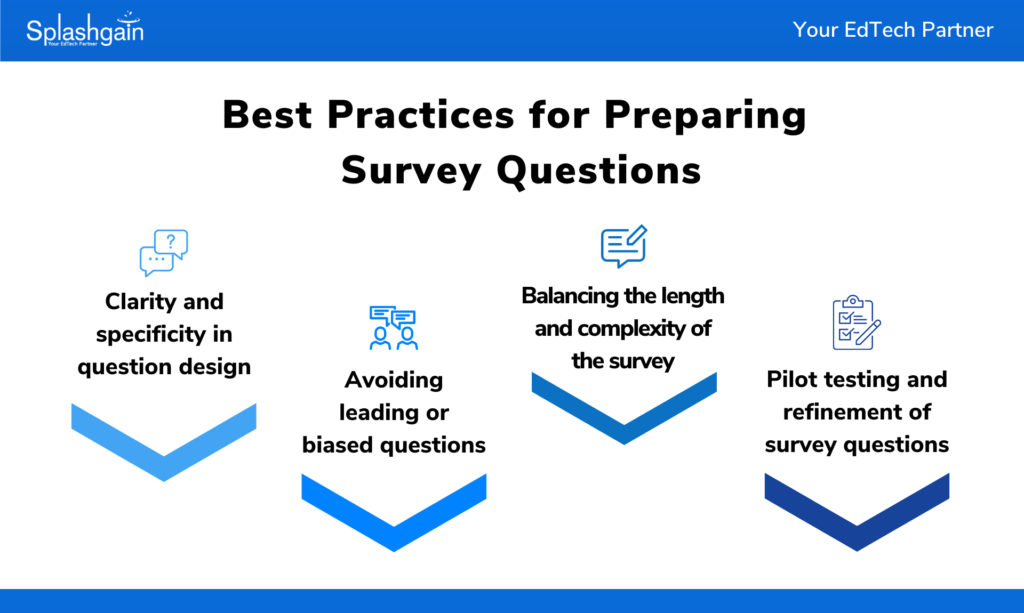
To create effective survey questions and gather valuable data, it is essential to follow best practices that enhance clarity, impartiality, and engagement. Following best practices for preparing survey questions is crucial because it directly impacts the quality and reliability of the data collected.
Clear and unbiased questions ensure that respondents understand the intent and can provide accurate responses, leading to more reliable insights for decision-making.
By minimizing response bias and maintaining impartiality, the survey results become more valid and representative of the target population. Additionally, engaging survey questions enhance participant interest and motivation, resulting in higher completion rates and a more comprehensive dataset. Here are some key tips for preparing survey questions:
A. Clarity and specificity in question design
- Keep questions simple and straightforward, avoiding jargon or technical language.
- Use precise wording to ensure respondents understand what is being asked.
- Avoid double-barreled questions that combine multiple inquiries, making it challenging for participants to provide accurate responses.
B. Avoiding leading or biased questions
- Formulate questions in an unbiased manner, without expressing opinions or assumptions.
- Steer clear of leading phrases that may influence respondents to answer in a certain way.
- Aim for a neutral tone to maintain the objectivity of the survey.
C. Balancing the length and complexity of the survey
- Be mindful of the respondents’ time and attention by keeping the survey as concise as possible.
- Prioritize essential questions and avoid unnecessary repetition or duplication.
- Group-related questions logically, making it easier for participants to navigate the survey.
D. Pilot testing and refinement of survey questions
- Conduct a small-scale pilot test with a few samples to identify potential issues and areas for improvement.
- Gather feedback from pilot participants to assess question clarity and relevance.
- Use the feedback to refine and fine-tune the survey questions before launching the full-scale survey.
Avoiding Common Mistakes
When creating a survey, it’s essential to follow best practices and avoid common mistakes for gathering accurate and valuable data. By doing so, institutes can improve the quality and reliability of their findings, leading to more informed decision-making.
Avoiding errors such as biased questions, ambiguous language, or survey fatigue helps maintain respondents’ trust and encourages honest responses. Ultimately, adhering to these guidelines enhances the overall effectiveness of the survey, yielding meaningful insights that can drive us in the right direction. Here are some key tips to keep in mind:
- Clarity and specificity: Ensure that questions are clear and straightforward, with precise wording to avoid confusion and get accurate responses.
- Avoid ambiguous or double-barreled questions: Stick to one topic per question, so respondents can provide focused answers without getting puzzled.
- Use simple language: Avoid using technical jargon or complex terms that might confuse participants; opt for plain and understandable language.
- Keep the survey concise: Shorter surveys are more likely to maintain respondent interest, preventing survey fatigue and increasing completion rates.
- Include “Not Applicable” or “Don’t Know” options: Let participants skip questions that don’t apply to them or when they lack the necessary information.
By following these guidelines, survey creators can ensure their questionnaires are effective, encouraging higher response rates and gathering meaningful insights for improving course and program outcomes.
Survey Frequency for Assessment
When assessing course and program outcomes through surveys, finding the right balance in survey frequency is crucial to gather relevant and timely data without overwhelming stakeholders. Strategic intervals for survey administration allow for meaningful feedback throughout the learning journey, ensuring adjustments and improvements can be made promptly.
Incorporating both periodic and end-of-program surveys offers a comprehensive perspective on the effectiveness of courses and programs. Periodic surveys provide ongoing insights into students’ experiences and progress, while end-of-program surveys allow participants to reflect on the overall learning journey.
To enhance feedback collection, educational institutions can implement ongoing feedback mechanisms such as regular check-ins, suggestion boxes, anonymous channels, and quick polls. These continuous feedback approaches keep institutions responsive to immediate concerns and foster a culture of open communication.
- Determine appropriate survey intervals to avoid overwhelming stakeholders.
- Periodic surveys offer ongoing insights and timely adjustments.
- End-of-program surveys assess the overall learning experience.
- Combine periodic and end-of-program surveys for comprehensive feedback.
- Implement ongoing feedback mechanisms for real-time concerns.
Accreditation & Surveys: Key Role
Accreditation plays a crucial role in improving the quality of academic programs by validating an institution’s commitment to high educational standards. Through rigorous evaluations, accrediting bodies assess various aspects of the institution, including learning outcomes, teaching methods, faculty qualifications, and student support services.
Obtaining accreditation demonstrates the institution’s dedication to continuous improvement and accountability, instilling confidence in students and stakeholders about the quality of education provided.
In the accreditation process, survey data holds significant importance as it helps assess program outcomes and supports continuous improvement efforts. Accredited institutions must meet specific standards for survey design, administration, and data analysis to ensure reliability and alignment with their goals. Survey feedback helps identify areas for improvement, facilitates data-driven decisions, and showcases how changes are informed by student input.
Incorporating survey data during accreditation showcases the institution’s commitment to student success and adaptability to evolving needs. Analyzing survey insights enables data-driven decisions to enhance the overall learning environment.
Accreditation bodies recognize the value of survey data in assessing program effectiveness, promoting accountability, and driving continuous enhancements for optimal educational outcomes.
- Accreditation validates institutional dedication to high educational standards.
- Rigorous evaluations cover learning outcomes, teaching methods, faculty qualifications, and student support services.
- Survey data is crucial for assessing program outcomes and supporting continuous improvements.
- Accredited institutions meet specific standards for survey design and data analysis.
- Incorporating survey data showcases commitment to student success and a culture of continuous improvement.
Survey Results and Accreditation
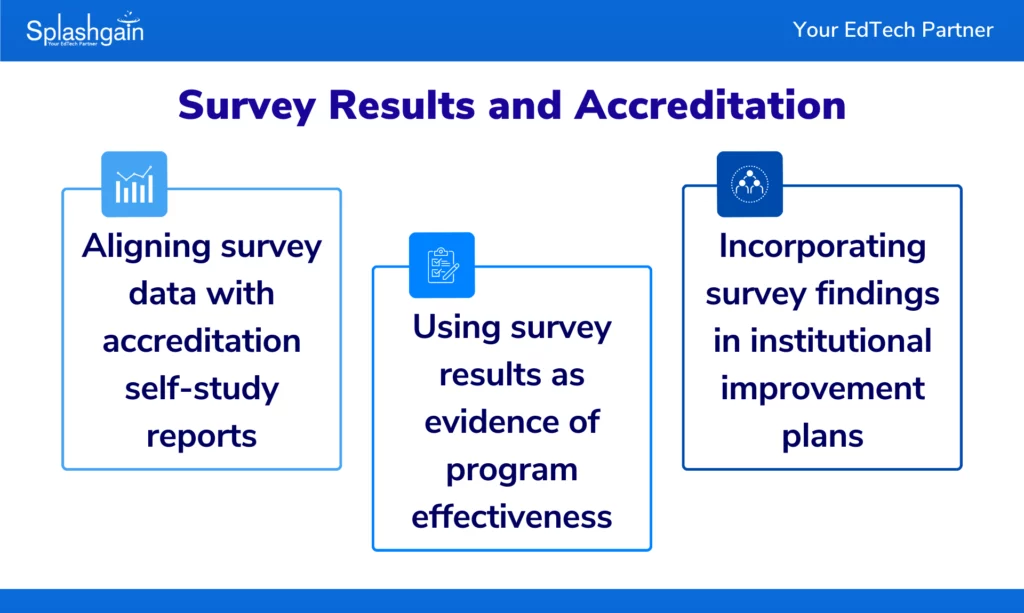
A. Aligning survey data with accreditation self-study reports
Integrating survey data into accreditation self-study reports is a powerful way to demonstrate an institution’s commitment to using feedback for continuous improvement. By showcasing how survey results inform decision-making and drive positive changes, the institution validates its dedication to meeting accreditation requirements.
This alignment reinforces transparency and accountability, providing accrediting bodies with valuable insights into how the institution leverages survey data to enhance its programs and services.
B. Using survey results as evidence of program effectiveness
Survey data serves as concrete evidence of an institution’s program effectiveness and its responsiveness to student needs. By analyzing survey responses, institutions can showcase the impact of their educational programs on student learning outcomes, overall satisfaction, and academic experiences.
Accrediting bodies rely on this data to assess program quality and alignment with educational goals. Utilizing survey results as evidence underscores the institution’s dedication to providing meaningful and impactful learning experiences.
C. Incorporating survey findings in institutional improvement plans
Survey results play a pivotal role in shaping institutional improvement plans. By identifying areas that require attention, institutions can proactively address concerns and implement changes to enhance overall effectiveness.
Including survey findings in improvement plans demonstrates a commitment to data-driven decision-making and responsiveness to student feedback. This integration fosters a culture of continuous improvement, ensuring that the institution evolves in response to changing needs and expectations.
In short, utilizing survey results to meet accreditation requirements is vital for institutions to show their commitment to excellence and student success. By aligning survey data with self-study reports, using survey results as evidence of program effectiveness, and incorporating survey findings into improvement plans, institutions demonstrate their dedication to continuous improvement and meeting accreditation standards through valuable feedback.
Benefits of Generating Surveys
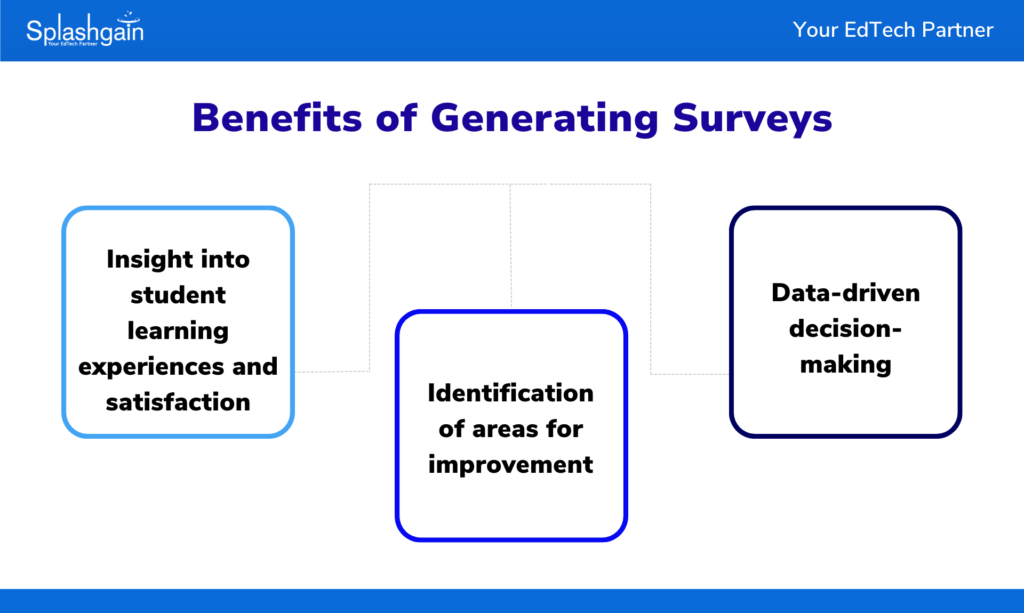
A. Insight into student learning experiences and satisfaction
Surveys provide a valuable platform for students to express their thoughts, concerns, and satisfaction levels throughout their academic journey. This feedback offers institutions a deeper understanding of student experiences, allowing them to identify successful practices and areas needing improvement. Key benefits include:
- Informed Decision-Making: Institutions can make informed decisions based on real student perspectives.
- Enhanced Student Support: Addressing concerns can lead to improved student support services.
- Increased Engagement: Student involvement in surveys fosters a sense of community and responsiveness.
B. Identification of areas for improvement
Through surveys, institutions can pinpoint specific aspects of courses and programs that require improvement. This feedback-driven approach enhances educational offerings and aligns them with students’ needs. Key benefits include:
- Targeted Enhancements: Focused interventions can be made based on survey data insights.
- Optimized Curriculum: Course and program modifications can cater to student preferences.
- Enhanced Teaching Methods: Feedback helps faculty adopt effective teaching strategies.
C. Data-driven decision-making
Survey data serves as a valuable resource for data-driven decision-making and long-term planning. It provides empirical evidence to support institutional strategies and resource allocation. Key benefits include:
- Evidence-Based Actions: Institutions can justify their actions with concrete survey data.
- Strategic Resource Allocation: Budgeting and resource allocation can align with survey insights.
- Improved Institutional Effectiveness: Surveys aid in setting clear and measurable goals.
By generating surveys, educational institutions gain valuable insights, driving continuous improvement, and enhancing the overall student experience.
Eklavvya – Automating Indirect Assessment
Eklavvya – Process Automation Platform for NBA / NAAC accreditation is purpose-built to streamline the accreditation journey for institutions. With its precision in CO-PO mapping, user-friendly interface, data-driven insights, and real-time analytics, the platform empowers institutions to make well-informed decisions, elevate student learning outcomes, and achieve academic excellence in their programs.
The platform serves as a powerful ally, seamlessly integrating direct and indirect assessment methods to create a comprehensive and effective evaluation process.
The indirect assessment feature proves highly effective due to its seamless integration with flexible survey form generation. Institutions can easily create various survey forms tailored to their specific needs. These forms can be shared with stakeholders through links, or institutes have the option to collect data separately and input it into the system via Excel.
Once the data input process is completed, the platform performs automatic calculations based on the weightage set by the institutes. This data is then utilized to calculate the attainment of course outcomes and program outcomes (CO-PO).
Institutions have the flexibility to choose which surveys to use for evaluation, and the system generates comprehensive results based on the collected data.
In summary, the indirect assessment feature offers a user-friendly and efficient way to generate and utilize survey data for CO-PO mapping. The platform’s flexibility empowers institutions to tailor surveys, collect data effortlessly, and calculate outcomes accurately, making it a valuable tool for continuous improvement in academic programs.
Conclusion
Surveys play an essential role in gathering valuable feedback and data to continually enhance academic programs. Through student perspectives and insights, institutions can identify strengths to maintain and areas requiring improvement.
Regular surveys create a feedback loop that fosters a culture of improvement, resulting in better course design, teaching methodologies, and overall program effectiveness.
Data-driven decision-making, facilitated by surveys, is instrumental in the accreditation process. Accrediting bodies recognize the significance of survey data in validating program effectiveness and institutional responsiveness to student needs.
Utilizing survey insights ensures that institutions can provide concrete evidence of their commitment to excellence and continuous improvement, which is highly valuable during the accreditation evaluation.
Recognizing the significance of surveys and incorporating them into the accreditation process is vital for educational institutions. Surveys enable institutions to elevate academic standards and create a positive learning environment that caters to student needs.
In conclusion, surveys serve as invaluable tools for institutions seeking to improve course and program outcomes and demonstrate dedication to excellence in the accreditation process. By embracing surveys and using data-driven decision-making, institutions can drive continuous improvement, achieve higher standards, and ensure a fulfilling learning experience for their students.
